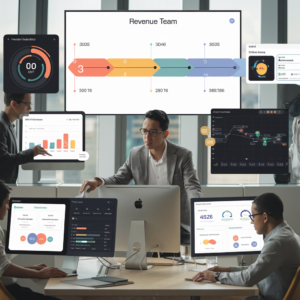
Why ‘Pipeline’ Is Dead: Rethinking Revenue Metrics in an AI World

For decades, the sales pipeline has been the North Star of revenue operations. Managers review pipeline health in weekly meetings, forecast revenue from deals in progress, and allocate resources based on what the pipeline data suggests. But here’s the uncomfortable truth: pipelines are failing us. They’re static, lagging indicators that reflect past activity, not future outcomes. In an AI-powered world, where speed and precision define success, clinging to outdated pipeline metrics puts businesses at a disadvantage.
AI is reshaping the way revenue teams operate, and at the center of this transformation is AI Signal Scoring—a dynamic, predictive approach to revenue tracking. Instead of relying on static snapshots of pipeline health, AI signals provide real-time insights, flagging deal risks, buying signals, and team efficiency metrics. This isn’t just an evolution of the pipeline; it’s a complete rethinking of how we measure revenue potential.
The shift to AI Signal Scoring marks the death of the traditional pipeline as we know it. It’s not a slight adjustment—it’s a revolution. Let’s explore why pipelines no longer serve modern sales teams, how AI offers a better solution, and what adopting this new approach means for revenue leaders.
The Problem with Pipelines
The concept of the sales pipeline is simple: track deals as they progress through defined stages, from initial contact to close. While this linear approach worked well in the past, it is fundamentally flawed in today’s fast-moving markets. Pipelines are reactive by design—they rely on data that is already stale by the time it’s reviewed. This creates blind spots that can derail even the most sophisticated revenue teams.
Consider the standard pipeline review. Managers often find themselves asking reps why specific deals are stalled or whether buyers have gone dark. These discussions are typically backward-looking and anecdotal, with reps speculating about deal progress. The pipeline might show that a deal is in the “negotiation” stage, but it offers no insight into whether that deal is actually likely to close, or what specific actions the rep should take to improve its odds. In short, pipelines tell you what has happened but not what will happen.
Static pipeline data also fails to account for critical nuances. A single-stage movement in the pipeline could mean vastly different things depending on the buyer’s behavior, the competitive landscape, or internal team dynamics. Traditional CRMs—designed to support pipeline management—can’t capture these complexities. The result? Teams pour hours into pipeline reviews without gaining actionable insights, leading to wasted time, misaligned priorities, and missed opportunities.

Enter AI Signal Scoring: The Future of Revenue Metrics
AI Signal Scoring flips the pipeline paradigm by focusing on real-time, predictive insights instead of static, stage-based tracking. It moves beyond binary stages like “negotiation” or “demo scheduled” to surface deeper signals about deal health, buyer intent, and team performance. The goal isn’t to track where a deal is—it’s to understand where it’s going and how to get it there faster.
For example, AI Signal Scoring uses machine learning to analyze buyer behaviors such as email responsiveness, meeting engagement, and website activity. It cross-references this data with external market signals like competitive pressures or economic trends, to predict deal outcomes. These insights are presented as dynamic scores, which reps and managers can act on immediately.
Instead of asking, “What stage is this deal in?” teams can ask, “What specific actions will move this deal forward?” Signal Scoring prioritizes the next best steps, whether that’s scheduling a follow-up meeting, involving an executive sponsor, or addressing buyer concerns earlier in the process.
Startups like Ebsta and Toplyne are leading the charge in this space. Ebsta integrates with CRMs to analyze relationship strength and engagement metrics, offering clear signals on which deals need attention. Toplyne, on the other hand, uses AI to predict revenue potential by analyzing product usage patterns in SaaS businesses. These tools provide actionable insights that go far beyond the static nature of traditional pipelines.
A Dynamic System for Dynamic Markets
One of the most compelling advantages of AI Signal Scoring is its ability to adapt to changing market conditions in real time. Unlike pipelines, which operate on fixed frameworks, AI signals continuously evolve based on new inputs. This is especially critical in volatile markets, where buyer priorities can shift overnight.
Take, for instance, a company using Opensense to monitor buyer engagement with personalized email campaigns. If engagement drops sharply after a competitor launches a new product, the system immediately flags the risk and suggests strategies to counteract it. This agility allows revenue teams to respond proactively, reallocating resources or adjusting their approach before deals are lost.
In addition to external signals, AI Signal Scoring enhances internal alignment. Tools like Vitally.io offer visibility into cross-functional collaboration, helping sales, marketing, and customer success teams align their efforts more effectively. When these teams are operating on the same real-time data, they can drive higher win rates and shorten sales cycles.
From Pipeline Reviews to Signal Reviews
Transitioning from traditional pipeline reviews to AI Signal Reviews requires a cultural shift. Revenue leaders must let go of outdated habits, such as rigid stage-based forecasts, and embrace a more fluid, dynamic approach. AI Signal Reviews focus on discussing actionable insights rather than rehashing static data.
A typical Signal Review might involve the following: (image from momentum.io)

momentum.io
- Risk Assessment: Which deals are at risk based on buyer engagement and external factors?
- Opportunity Scoring: Which accounts show high intent but need additional focus to convert?
- Team Performance Metrics: How effectively is each rep leveraging AI signals to improve deal outcomes?
These discussions are forward-looking, empowering teams to make decisions that directly impact results. Moreover, they eliminate the guesswork that often plagues traditional pipeline reviews, replacing subjective opinions with data-driven strategies.
The Role of Leadership in Signal-Driven Revenue Models
Leaders play a critical role in adopting and optimizing AI Signal Scoring. By fostering a culture of agility, collaboration, and continuous improvement, leaders show they are focusing on more than just AI tech adoption. Leaders must set the tone by embracing AI insights and demonstrating their value in daily operations.
The shift away from traditional pipeline metrics isn’t just about adopting a new tool or methodology—it’s a fundamental change in how businesses think about and measure revenue potential. From predictive analytics to automation and NLP, these technologies are enabling revenue teams to operate with unprecedented precision and agility.
AI Concepts Powering the Death of the Pipeline
AI has opened a world of possibilities beyond the static, backward-looking metrics that have dominated sales and revenue operations for decades. At the heart of this transformation are several key AI technologies that work together to provide predictive, actionable insights in real time.
1. Predictive Analytics: Seeing the Future of Deals
Traditional pipelines are descriptive; they show what has happened and where deals currently stand. Predictive analytics takes this further, using historical and real-time data to forecast future outcomes. By analyzing patterns across thousands of deals, predictive models can identify which opportunities are likely to close and which are at risk long before these signals are visible in the pipeline.
How It Works:
Predictive analytics models leverage machine learning to continuously refine their understanding of buyer behavior. For example, if a prospect frequently engages with marketing emails and attends webinars but suddenly stops responding to follow-ups, the system can flag this as a high-risk deal. It might even recommend re-engagement strategies based on similar patterns observed in the past.
Why It Matters:
Instead of waiting for a stalled deal to show up as a problem in the pipeline, revenue teams can act preemptively. Predictive analytics eliminates the guesswork, replacing reactive measures with proactive interventions.
2. Natural Language Processing (NLP): Uncovering Hidden Signals
Sales conversations—whether over email, chat, or calls—contain valuable insights that traditional pipelines fail to capture. NLP enables AI systems to analyze these interactions for patterns, tone, and intent, surfacing signals that can’t be reduced to simple stage movements.
How It Works:
NLP processes unstructured data, such as emails or call transcripts, to extract actionable insights. For example, an AI system might detect hesitation in a buyer’s tone during a demo or identify recurring questions about a competitor’s offering in email exchanges. These insights can then be scored for urgency or relevance, providing reps with clear next steps.
Why It Matters:
By capturing the nuances of buyer communication, NLP allows revenue teams to identify opportunities and risks that pipelines miss entirely. It ensures that no critical signal gets lost in the noise of daily interactions.
3. Reinforcement Learning and Retrieval-Augmented Generation (RAG): Dynamic Decision Support
Reinforcement learning allows AI systems to improve decision-making over time by learning from outcomes. Coupled with Retrieval-Augmented Generation (RAG), which combines generative AI with external data retrieval, these technologies create a dynamic feedback loop for revenue teams.
How It Works:
When a rep engages with a prospect, RAG systems pull relevant data—such as competitive insights, previous deal outcomes, or buyer-specific preferences—from a variety of sources. Reinforcement learning ensures that the system becomes more accurate with each interaction, refining its recommendations based on real-world results.
Why It Matters:
RAG-powered systems go beyond static playbooks, offering dynamic guidance that evolves with the deal. This eliminates the need for manual pipeline updates, as the system continuously surfaces the most relevant data for decision-making.
4. Automation: Eliminating Bottlenecks
A significant problem with pipelines is the time and effort required to update them manually. Automation solves this by capturing and processing data across tools, systems, and interactions without human intervention.
How It Works:
Automated systems integrate with CRM platforms, communication tools, and marketing analytics to pull relevant data into a central hub. For example, if a rep logs a call, automation captures the key details, scores the deal’s health, and suggests follow-up actions—all without requiring the rep to update the pipeline.
Why It Matters:
Automation frees revenue teams from tedious administrative tasks, allowing them to focus on high-impact activities. It ensures that metrics are always up to date and accurate, providing a real-time view of revenue health.
5. Computer Vision: Context Beyond Conversations
While not traditionally associated with sales, computer vision is emerging as a valuable tool for understanding buyer engagement. For example, during video calls or product demos, computer vision systems can analyze facial expressions and body language to gauge buyer interest and sentiment.
How It Works:
Computer vision algorithms process visual cues in real time, identifying moments of disengagement or enthusiasm. This data can be combined with NLP and predictive analytics to create a comprehensive picture of deal health.
Why It Matters:
By analyzing buyer behavior beyond verbal communication, computer vision provides deeper insights into intent and alignment. This helps revenue teams make informed decisions about when to escalate or pivot their strategies.
When AI Technologies Work Together: The Multiplier Effect
The true power of AI lies not in isolated capabilities but in the synergy created when technologies like predictive analytics, NLP, RAG, automation, and computer vision work together seamlessly within an organization. Imagine a revenue team where predictive analytics forecasts the likelihood of deal closures, NLP uncovers hidden buyer intent from communication, RAG dynamically retrieves real-time market intelligence, automation eliminates administrative bottlenecks, and computer vision adds a layer of emotional and behavioral insights during buyer interactions. Combined, these technologies create a dynamic, interconnected system that operates with precision and foresight, far beyond the static confines of a pipeline.

Real-World Impact: Picture a sales team at a B2B SaaS company. A buyer engages with an automated webinar, and computer vision detects their heightened attention during specific product demos. This insight triggers RAG to surface related case studies and competitor comparisons, which are automatically emailed to the prospect. Meanwhile, predictive analytics flags the deal as high-conversion potential based on past behaviors, prompting NLP-driven email templates for the rep to send follow-ups tailored to the buyer’s unique concerns. All these insights are fed into the CRM without human intervention, allowing the rep to focus on a high-value negotiation call. This integrated system doesn’t just replace pipeline metrics because it literally renders them obsolete, providing a real-time, holistic view of deal health and next steps.
The result? Faster sales cycles, higher win rates, and a team empowered by actionable, forward-looking insights at every stage of the process. In this environment, the pipeline ceases to be a limiting construct and evolves into an ecosystem of intelligence that drives real results.
Why AI Signals Outperform Pipelines
The technologies outlined above are fundamentally changing how revenue is tracked and forecasted. Here’s why AI Signal Scoring outperforms traditional pipeline metrics on every front:
- Real-Time Insights: Unlike pipelines, which rely on periodic updates, AI systems provide a continuous stream of actionable insights. This ensures that teams are always working with the latest data.
- Holistic View: AI integrates multiple data sources—engagement metrics, market trends, and buyer sentiment—to create a comprehensive picture of deal health. Pipelines, by contrast, are limited to static stage updates.
- Actionable Guidance: While pipelines tell you where a deal is, AI signals tell you what to do next. Whether it’s scheduling a follow-up meeting or looping in a key stakeholder, AI provides clear recommendations to move deals forward.
- Adaptability: AI systems are dynamic, evolving with new data and changing market conditions. Pipelines remain rigid, offering little flexibility in the face of uncertainty.
Building a Signal-Driven Revenue Culture
Adopting AI Signal Scoring requires more than just implementing new technology. It’s a cultural shift that starts with leadership. Teams must embrace a mindset of agility, collaboration, and continuous improvement, driven by real-time data rather than static processes.
Start with Education
Leaders must educate their teams about the limitations of pipelines and the benefits of AI-driven metrics. This includes demystifying technologies like NLP, predictive analytics, and automation, ensuring that teams understand their value.
Redefine Success Metrics
Traditional pipeline metrics like stage velocity or deal value must give way to more nuanced KPIs, such as buyer engagement scores or risk mitigation rates. These metrics reflect the dynamic nature of AI Signal Scoring and align with the realities of modern sales.
Foster Collaboration
AI signals are most effective when shared across teams. Marketing, sales, and customer success must operate on a unified data set, ensuring that insights are leveraged at every stage of the buyer journey.
How to Move from Pipeline Metrics to AI Signals
“Ok Coach, so I am reading this and I can see your point, how the heck do I get from here to the amazing world you speak of?”
It’s a great question, and one that deserves a thoughtful, actionable answer. Moving from a traditional pipeline-based revenue model to one powered by AI signals is not an overnight transformation. It’s a structured journey, one that begins with understanding your current state, aligning your goals, and implementing changes that create measurable impact. Here’s how you can get there in a series of strategic steps:
Step 1: Start with a Gap Analysis
Before you can implement AI signals, you need to understand where your pipeline metrics are falling short and what gaps exist in your current revenue operations. Conduct a gap analysis aligned with your revenue goals to pinpoint the areas that are holding you back.
For example, if your business goal is to increase win rates by 20%, ask:
- Where are deals falling through the cracks?
- What critical signals are being missed during buyer interactions?
- Which activities are consuming time but providing little value?
This gap analysis helps identify not just weaknesses in your pipeline but also the specific problems that AI signals can solve to help you meet your goals.
Step 2: Redefine Success Metrics
Traditional pipeline metrics, like deal stage progression or pipeline velocity, are no longer sufficient. Redefine success by incorporating predictive, forward-looking KPIs that align with AI signal scoring. Metrics to consider include:
- Buyer engagement scores (e.g., response rates, time spent in demos).
- Deal risk alerts based on patterns of inactivity or negative sentiment.
- Team-wide efficiency markers like time-to-value for each sales stage.
Redefining success metrics creates a clear vision of what “better” looks like and provides a benchmark for evaluating AI-driven improvements.
Step 3: Identify and Test AI Technologies
Selecting the right AI technologies is critical. Instead of diving headfirst into a full implementation, start with a proof of concept (PoC) or test run. Assemble a tiger team—a small, agile group of sales reps—to test tools in real-world scenarios and measure their effectiveness.
Here’s how to approach this step:
- Research Tools: Use resources like the GTM AI Demo Tools Library to explore and compare AI technologies that match your needs. The library provides 55+ GTM AI demos of real tools, saving you time and helping you make informed decisions.
- Run a PoC: Test a short-list of tools with a test tiger team. Look for measurable improvements, such as better deal prioritization, higher buyer engagement, or reduced time spent on manual tasks.
- Evaluate Fit: Assess whether the technology integrates well with your existing tech stack and aligns with your business goals.
By starting small, you can identify the most effective tools and refine your approach before scaling across the entire team.
Step 4: Enable and Train Your Team
AI tools are only as effective as the people using them. Invest in training your team to ensure they understand how to leverage AI signals to their full potential.
- Train on Interpretation: Teach reps how to interpret AI-driven insights, such as risk scores or recommended next steps.
- Incorporate into Workflows: Show your team how to integrate these signals into their daily routines, making AI a natural extension of their sales process.
- Address Resistance: Be transparent about the benefits of AI and address concerns that it might replace human skills. Emphasize that AI is a tool to augment their expertise, not replace it.
Leadership must lead by example, demonstrating how to use AI tools effectively and championing their adoption.
Step 5: Shift Your Revenue Cadence
Replace your pipeline reviews with signal reviews. These discussions focus on actionable insights rather than backward-looking metrics. Use AI signals to drive the conversation:
- Which deals are showing signs of buyer intent?
- What risks need to be addressed immediately?
- How can resources be reallocated to maximize deal outcomes?
Signal reviews keep your team aligned, agile, and focused on what matters most.
Step 6: Iterate and Scale
Once you’ve tested AI signals with a tiger team, gathered insights, and refined your processes, it’s time to scale. Roll out the technology across your organization, ensuring that the lessons learned during the PoC phase are applied.
AI systems continuously evolve as they process more data, so this is not a one-and-done process. Regularly review performance metrics, gather feedback from your team, and make adjustments to keep improving.
The Path Forward
Moving from static pipeline metrics to dynamic AI signals requires a mindset shift and a willingness to embrace new technologies. It’s not without challenges, but the rewards—faster deal cycles, higher win rates, and more efficient teams—are worth it.
This journey starts with understanding where you are, defining where you want to go, and taking the practical steps needed to get there. Use gap analysis to identify what’s holding you back, test tools with a tiger team, and empower your team with the training they need to succeed.
With the right plan and the right tools, you’ll not only eliminate the limitations of traditional pipelines—you’ll redefine what success looks like for your entire organization.
Conclusion: The Death of the Pipeline
The pipeline isn’t evolving—it’s being replaced. AI Signal Scoring offers a fundamentally better way to track, forecast, and drive revenue. By leveraging technologies like predictive analytics, NLP, and automation, revenue teams can shift from reactive pipeline reviews to proactive, signal-driven strategies.
In an AI-powered world, clinging to outdated pipeline metrics is like navigating with a paper map in the age of GPS. The companies that embrace AI signals will move faster, operate smarter, and close deals with greater precision. Those that don’t? They’ll be left behind, stuck in the bottlenecks of their static pipelines.
The time to rethink your metrics is now. The question isn’t whether your pipeline is dead—it’s whether you’re ready to adopt what’s next.
































